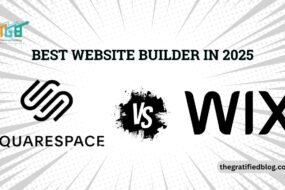
In the realm of website design, the choice between static and dynamic websites can be a challenging decision to make. Establishing an online presence is vital for businesses in today’s digital landscape, and the static vs. dynamic website debate is a common one, each with its own set of pros and cons.
Selecting the most suitable website type for your business is crucial, as it can significantly impact your online presence, user experience, and overall business objectives.

In this blog, we will delve deeper into static vs. dynamic websites, conduct a thorough comparison of their advantages and disadvantages, and offer expert recommendations to help you make the right choice for your business.
So, Let’s begin.
What Are Static Websites?
A static website is a type of website that is made up of fixed, pre-built web pages stored on a web server.
These web pages are created using client-side languages like HTML, CSS, and JavaScript and are delivered to the user exactly as they were created. The files comprising a static website are stored on the server and remain unchanged unless manually edited.
However, these websites are typically used for small businesses, portfolios, and informational websites that don’t require frequent updates.
Now let’s talk about the advantages and disadvantages of it.
Advantages And Disadvantages Of Using Static Websites
Advantages
- Speed: They are speedy because the web pages are pre-built and don’t require server-side scripting. This can result in faster load times, leading to a better user experience and higher search engine rankings.
- Security: Because they are not connected to a database or server-side scripting, they have fewer security vulnerabilities. This can be particularly important for businesses that handle sensitive information.
- Simplicity: Static websites boast straightforward creation and maintenance processes, requiring minimal technical know-how. Hosting these websites on affordable servers further streamlines the entire setup, making them an ideal choice for those seeking hassle-free website management.
- Cost-Effective: With their budget-friendly development and hosting options, static websites present an attractive solution, particularly for small businesses and individuals operating on limited financial resources. Their affordability allows these entities to establish a solid online presence without straining their budgets.
Disadvantages
- Limited Functionality: As the web pages in static websites are pre-built, they have limited functionality and cannot be customized easily. This type of website does not support user interaction or data input.
- Difficulty In Updating Content: Updating content on a static website requires knowledge of HTML and CSS, which can be challenging for business owners without a web development background. This can lead to delays in updating content or errors in updating content.
- Scalability: These websites are not easily scalable; each page must be manually created and updated. This can be problematic for businesses that are growing or require frequent updates to their website.
Now Let’s understand Dynamic Website
What Are Dynamic Websites?
A dynamic website is a type of website that enables the creation and display of dynamic content based on user interactions and server-side scripting.
Unlike static websites that display the same content in the same format to all visitors, dynamic websites can present different information to different visitors. This is because dynamic websites can generate content on-the-fly based on user input and other variables.
Now let’s talk about the advantages and disadvantages of it.
Advantages And Disadvantages Of Using Dynamic Websites
Advantages
- Flexibility: These websites are very flexible and can be customized to fit the specific needs of a business. They can handle various content types, from blogs to e-commerce sites.
- Interactivity: These websites allow for user interaction and data input, which can lead to a more engaging user experience. This can be particularly important for businesses that require user engagement or feedback.
- Easy Content Updates: Updating content on a dynamic website is easy because it can be done through a content management system (CMS). This allows business owners to update their websites without any knowledge of web development.
- Search Engine Optimization: Dynamic websites are search engine friendly because they allow for creating unique, dynamic content. This can lead to higher search engine rankings and increased visibility for the business.
Disadvantages
- Security: These websites are more susceptible to security vulnerabilities because they are connected to a server-side scripting language and database. This can be particularly problematic for businesses that handle sensitive information.
- Cost: These websites can be more expensive to build and maintain than static websites because they require a more complex infrastructure and specialized skills. This can be a barrier for small businesses or individuals with limited budgets.
You have now understood their meaning, advantages, and disadvantages. Now let’s compare them both.
Comparison Of Static vs Dynamic Websites
Well, there are several differences, but Here are five critical comparisons between static and dynamic websites:
Content Management
Static websites are built using fixed HTML and CSS files, requiring manual editing for content updates. On the other hand, dynamic websites use a content management system (CMS) that allows for easy updates without coding knowledge.
For example, a static website for a small business may require the business owner to update information about their products or services manually. A dynamic website using a CMS such as WordPress would allow the business owner to update their content through an intuitive interface easily.
Customization
Static websites are limited in their ability to customize content and features, as they are built with fixed HTML and CSS files. Dynamic websites, however, allow for more customization through the use of server-side scripting and databases.
For example, a static website for a restaurant may have a fixed menu that cannot be easily updated or customized. A dynamic website using a CMS and database could allow the restaurant to update its menu easily and offer online ordering.
User Interaction
Static websites only allow minimal user interaction beyond clicking links or submitting forms. On the other hand, dynamic websites allow for more user engagement through features such as comments, ratings, and reviews.
For example, a static website for a book club may only provide information about upcoming meetings. A dynamic website using a CMS and user interaction features could allow members to share book recommendations and discuss books online.
Speed
Static websites load faster than dynamic websites because they do not require server-side scripting or database queries. This can be important for user experience and search engine optimization.
However, advances in caching and content delivery networks (CDNs) have made dynamic websites faster and more responsive.
For example, a static website for a photography portfolio may load quickly and showcase beautiful images. A dynamic website using caching and CDNs could achieve the same speed and interactivity while allowing for more accessible updates and customization.
Factors To Consider When Choosing Between Static And Dynamic Websites

When choosing between static vs. dynamic websites, there are several factors to consider to ensure that you choose the right type of website for your needs. Here are some key factors to consider:
- Type Of Content
Consider the content you will publish on your website. Static websites are best suited for simple websites that do not require frequent updates, such as a primary brochure site or a personal blog.
Dynamic websites are better suited for websites that require frequent content updates, such as e-commerce sites or news portals.
- Functionality
Consider the functionality that you need on your website. Static websites are limited in terms of functionality and are best suited for websites that require only basic features, such as information pages or image galleries.
On the other hand, dynamic websites are better suited for websites that require more advanced functionality, such as e-commerce, social networking, or user-generated content.
- Maintenance
Consider the level of maintenance required for your website. Static websites are relatively easy to maintain as they do not require server-side scripting or database connections.
On the other hand, dynamic websites require more maintenance as they require server-side scripting and database connections. This can be a consideration if you need more technical expertise to maintain a dynamic website.
- Cost
Consider the cost of building and maintaining your website. Static websites are generally less expensive to build and maintain as they require less infrastructure and technical expertise.
On the other hand, dynamic websites can be more expensive to build and maintain as they require more infrastructure and technical expertise. This can be a consideration if you have a limited budget or need clarification on your technical expertise.
Dynamic Website Example
Wayfair (Dynamic Ecommerce Website)
Wayfair’s personalized shopping experience is well-known among its users. Through its dynamic website, the company curates product displays tailored to each customer, presenting items that align with their browsing history and past purchases.

Final Thoughts
With your newfound knowledge about static vs. dynamic websites, there’s no need to wait for a developer to start creating your website. You can get started today.
If you still struggle to create your website, please leave your questions in the comment section. We will be happy to answer you.
Thanks for reading 🙂








No Comments